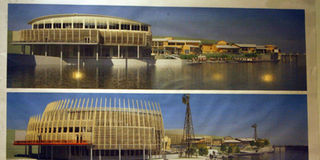Artists showcase dreams for modern city

Some of the pictures which were on exhibition during the, Dreams of Nairobi Re-Imagining Nairobi City Exhibition at the Goethe-Institute Auditorium on 31st January 2013. Photo/DANIEL IRUNGU.
What you need to know:
- African Urban Features’ designs seek to offer solutions to challenges facing Nairobi like poor housing, poor planning, lack of amenities
It begins with simple, exciting details like the half circle formed during a rural village baraza. Then the idea naturally expands. The result is the Kenya courts prototype, part of elegant urban designs dubbed Dreams of Nairobi.
Kenya courts prototype is one of the seven scintillating, provocative designs that are on exhibition at the Goethe-Institut in Nairobi. It literally depicts a baraza in which decision makers and advisers sit to decide on important matters.
The building, which is monumental in size, grows from and is linked to the surrounding landscape. Among the facilities are water treatment yard where waste water is recycled and reused within. Also, this building that generates its own energy has a Kenya prisons office as an extension.
Nairobi has been facing a rapid increase in population while growth in housing and infrastructures has been sluggish, even stagnant. Given this rapid urbanisation, there is an urgent need for the development of architectural and urban design solutions.
And in response to this, Nairobi-based think tank African Urban Futures has designed unique projects that could be adapted in guiding urban planning. The unique designs offer a clear break from the ordinary trends of loaf-shaped architecture around the city.
Among them are well-designed public facilities such as judicial courts, community centres, parks, and museums, with designers being fully aware of the emerging contemporary needs and urban trends.
One of the elements Nairobi lacks spaces for public gathering and recreation. This in turn discourages social interaction, and it is at this point that a proposed structure such as the Hope Community Centre Dagoretti comes about. Comprising social amenities, communal education, commercial outlets and sports divisions, this venue is intended to pump life into the city residents.
Intended to highlight the importance of our surroundings is the Nairobi Dam Environmental Awareness that creates a unique sense of place for the dam. It features access to the water while integrating the arts and creating interaction with the environment.
Another court model is one titled prototype for Kenyan court house. The idea behind it is offering maximum access to the public by proposing bus stops to be incorporated in a public boulevard that goes all around the site.
An open plaza is also accessible to the public for the sake of gatherings and exhibitions held by the judiciary. The scheme shows a total of six courtrooms and a similar number of hearing rooms arranged symmetrically on the upper floors of the building.
Each courtroom has supplementary offices attached in order to ensure smooth operations. These rooms are acoustically treated to ensure maximum audibility while at the same time ensuring privacy. In addition, the building has motion sensory light appliances installed so as to minimise energy wastage.
The artists have drawn inspiration from technology, local objects and Kenyan history. Take the instance of the Railway Museum which has a dreamy form. It is much like a slanting rectangular tunnel with glass walls and obsolete railway lines slithering within. The designers have in this case borrowed from the colonial legacy.
A different design exclusively renders every Kenyan a hero, likely a fact. The idea is preserving each ordinary Kenyan memory at the heroes’ corner at Jamhuri Park. It combines the rustic sense with timeliness, as the park is quite placed in a massive triangular pit.
The architects have also heaped appropriate attention to detail. Dreams of Nairobi: Re-imaging Nairobi City will run until February 15.




